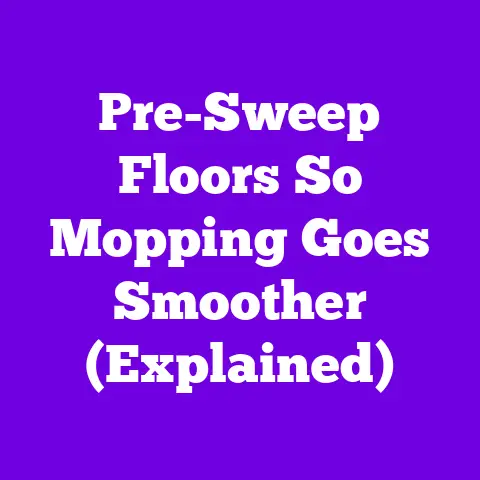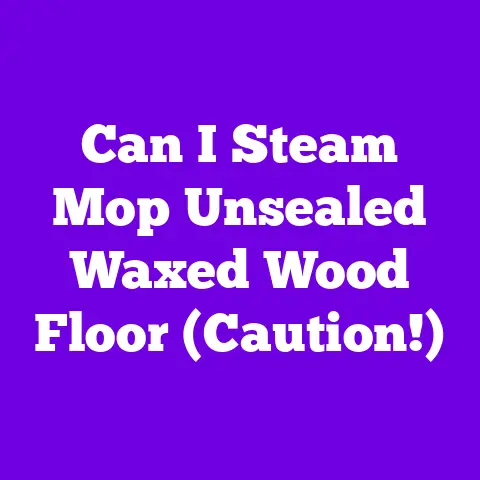What Is The Best Kind Of Mop (Top Picks)
A Mop Story: Finding the Best Fit for Your Floors
Picture this: You’re standing in your living room, sunlight streaming through the windows, casting a warm glow across the floor. There’s an unmistakable satisfaction in seeing your floors gleam with cleanliness. Achieving this sparkle often involves choosing the right mop — a decision more nuanced than you might expect. Over the years, I’ve explored the ins and outs of mopping, and I’m here to share everything I’ve learned.
Choosing the Right Mop: An Adventure in Cleaning
Standing in the cleaning aisle, surrounded by an array of mops, can be overwhelming. They all promise the best clean, but which one is truly right for your floors? Having navigated this maze multiple times, I’ve discovered that the perfect mop is not one-size-fits-all. It’s about matching the mop to your specific needs and floor types.
Types of Mops: A Closer Look
Let’s break down the different types of mops and explore their features, benefits, and best use cases. This will help you determine which mop might become your new cleaning companion.
String Mops
Traditionally, string mops have been a staple in many households. They consist of a bundle of absorbent fibers attached to a handle. These mops are excellent for textured or uneven surfaces due to their ability to reach into crevices.
Pros:
- Absorbency: String mops can hold a lot of liquid, making them ideal for soaking up spills.
- Versatility: Suitable for various floor types, including tile and concrete.
Cons:
- Weight: When saturated, these mops can become heavy and cumbersome to use.
- Maintenance: They require thorough cleaning and proper drying to prevent mildew.
My Experience: I remember using a string mop during my early days as a professional cleaner. It was fantastic for deep cleaning sessions in large spaces but less practical for quick touch-ups at home.
Sponge Mops
Sponge mops have a rectangular sponge head attached to a wringing mechanism. They are particularly effective on smooth surfaces and are known for their scrubbing power.
Pros:
- Scrubbing Capability: The sponge material can effectively scrub away dirt and grime.
- Ease of Use: They are generally easy to maneuver around furniture and tight spaces.
Cons:
- Streaks: If not wrung out well, they can leave streaks on the floor.
- Durability: The sponge can wear out over time and may need frequent replacement.
My Experience: I transitioned to a sponge mop for my kitchen tiles. Its scrubbing ability was unmatched, making it perfect for tackling sticky spills.
Flat Mops
Flat mops are characterized by a flat head with a microfiber or cloth pad. They are popular for their lightweight design and efficiency on hardwood and laminate floors.
Pros:
- Lightweight: Easy to handle and maneuver across large areas.
- Eco-Friendly: Microfiber pads are reusable and require minimal chemicals.
Cons:
- Limited Absorbency: Not ideal for soaking up large spills.
- Pad Cleaning: Requires regular washing to maintain effectiveness.
My Experience: With hardwood floors in my living room, I found flat mops to be a lifesaver. Their gentle touch preserved my floor’s finish while picking up dust effortlessly.
Steam Mops
Steam mops use hot steam to clean and sanitize floors without chemicals. They are equipped with a water tank that heats up to produce steam.
Pros:
- Sanitization: Kills bacteria and germs without the need for harsh chemicals.
- Quick Drying: Floors dry quickly due to the minimal water used.
Cons:
- Floor Compatibility: Not suitable for unsealed wood or delicate surfaces.
- Electrical Caution: Requires careful handling around water-sensitive areas.
My Experience: I invested in a steam mop for my bathroom tiles. It was fantastic for giving the space a hygienic clean without any chemical residue.
Personal Experiences: My Mop Journeys
Throughout my years of cleaning, I’ve encountered various challenges that have taught me valuable lessons about mop selection. Let’s delve into some of these experiences to provide a richer understanding of how different mops can be utilized effectively.
The String Mop Saga
During my first professional cleaning job, I was tasked with maintaining a large commercial space with high foot traffic. The string mop became my go-to tool for its absorbency. It handled everything from coffee spills to muddy footprints with ease. However, I quickly learned the importance of properly wringing out the mop to avoid leaving water puddles that could become slipping hazards.
Sponge Mop Adventures
When I moved into an apartment with tiled kitchen floors, I switched to a sponge mop. It was perfect for scrubbing away food stains and grease splatters. One memorable instance was after hosting a dinner party — the aftermath in the kitchen was daunting, but my trusty sponge mop made cleanup swift and satisfying.
Flat Mop Discoveries
The transition to hardwood floors in my home brought new challenges. I needed something gentle yet effective, leading me to flat mops with microfiber pads. These mops became essential during shedding season from my furry companions. They picked up pet hair effortlessly without scratching the floor’s surface.
Steam Mop Revelations
Investing in a steam mop was a game-changer for bathroom cleaning. The ability to sanitize without chemicals was appealing, especially with small children around. The steam mop became my tool of choice for maintaining hygiene in high-touch areas like bathroom floors and kitchen counters.
Assess Your Floor Type
- Identify Your Floors
Take note of the different floor types in your home — tile, wood, laminate, etc. Each has unique maintenance requirements. - Consider Floor Finish
Are your wood floors sealed or unsealed? This will influence whether steam cleaning is an option. - Evaluate Floor Condition
Are your floors new or worn? Older floors may require gentler cleaning methods to preserve their integrity.
Understand Your Cleaning Needs
- Frequency of Cleaning
How often do you clean? Regular maintenance might require different tools compared to occasional deep cleaning. - Type of Messes
Do you deal with dust, spills, or pet hair? Different mops tackle specific messes more efficiently. - Allergy Considerations
If allergies are a concern, consider mops with microfiber pads that trap allergens effectively.
Match Mop to Floor
- Tile Floors
Opt for sponge or steam mops. They handle grout lines well and offer effective scrubbing capabilities. - Wood Floors
Flat mops are your friend here. They protect the finish and avoid excess water that can cause warping. - Laminate Floors
Similar to wood, flat mops work best, keeping moisture minimal while effectively picking up dirt. - Concrete Floors
String mops are ideal due to their absorbency and ability to clean textured surfaces efficiently.
Mistakes to Avoid: Mop Blunders
Even seasoned cleaners like myself have made mistakes along the way. Here are some common pitfalls to avoid when mopping:
- Using Too Much Water
Particularly on wood and laminate floors, excessive water can cause damage over time. Always wring out your mop thoroughly before use. - Neglecting Mop Maintenance
Failing to clean or replace your mop head can result in spreading dirt rather than removing it. Regularly wash or replace mop heads as needed. - Ignoring Floor Type Compatibility
Using the wrong mop on certain floor types can lead to damage or ineffective cleaning. Here are some tips to ensure safe and efficient mopping:- Wear Non-Slip Shoes
Wet floors can be hazardous; wearing shoes with good traction helps prevent slips and falls. - Use Warning Signs
In commercial settings or busy households, consider using wet floor signs to alert others of potential hazards. - Avoid Electrical Hazards
Be cautious when using steam mops near electrical outlets or appliances. Keep cords away from water sources. - Proper Handling of Cleaning Solutions
If using chemical cleaners, follow manufacturer instructions for dilution and application to avoid damage or accidents.
Top Picks: My Favorite Mops and Why
Over the years, I’ve tried numerous mops in various settings — from bustling commercial spaces to cozy homes. Here are some of my top picks based on performance and reliability:
- O-Cedar EasyWring Microfiber Spin Mop
- Features a hands-free wringing system that makes it easy to remove excess water.
- The triangular mop head reaches corners effortlessly, making it versatile for different spaces.
- Ideal for both wet and dry cleaning tasks with its highly absorbent microfiber material.
- Bissell PowerFresh Steam Mop
- Offers chemical-free sanitization using hot steam, ideal for families with children or pets.
- Comes with multiple settings for different floor types, ensuring safe usage.
- Equipped with fragrance discs for optional scent infusion during cleaning sessions.
- Rubbermaid Reveal Spray Mop
- Lightweight design with reusable microfiber pads that are gentle on delicate surfaces.
- Built-in spray trigger allows easy application of cleaning solution without bulky buckets.
- Suitable for quick touch-ups or thorough cleans on hardwood and laminate floors.
FAQs: Answering Your Mop Questions
Let’s address some common questions about mopping to ensure you’re equipped with all the knowledge needed for effective cleaning:
Q: How often should I replace my mop head?
A: For regular use, it’s recommended to replace your mop head every 2-3 months or sooner if it shows signs of wear or odor retention.Q: Can I use a steam mop on all floor types?
A: No, steam mops should be avoided on unsealed wood or delicate surfaces as the heat and moisture can cause damage over time.Q: What’s the best way to clean a mop head?
A: If machine washable, wash on a gentle cycle with mild detergent. Otherwise, soak in hot water mixed with vinegar or baking soda to remove dirt and odors.Q: Are microfiber pads better than traditional mop heads?
A: Microfiber pads offer excellent dust and allergen trapping capabilities while being gentle on surfaces, making them ideal for regular maintenance on most floor types.Learn more
- Wear Non-Slip Shoes






